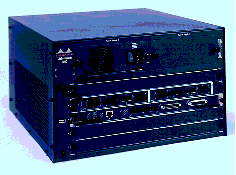You have no items in your shopping cart.
0item(s)
You have no items in your shopping cart.
0 in stock
The LightStream 1010 is the first member of Cisco Systems' midrange Asynchronous Transfer Mode (ATM) switches for multiservice applications—from the ATM workgroup and campus backbone to metropolitan-area networks and alternative service provider backbones.
The LightStream 1010 is the first in a series of switches that will span from 5 to 40 Gbps, providing services optimized for both cell- and packet-based applications.
The LightStream 1010 is an excellent complement to the Cisco BPX, AXIS, and IGX WAN switches as well as the Cisco MC3810 multiservice access concentrator, for an integrated ATM WAN backbone. The LightStream 1010, Catalyst multilayer LAN switches, and Cisco routers are the foundation for many large campus ATM networks based on LAN Emulation and Multiprotocol over ATM (MPOA) today. The LightStream 1010 switch processor and port modules can be used in the Catalyst 5500 multilayer LAN switch, providing many options for deployment in addition to investment protection. In metropolitan-area networks, the LightStream 1010 and Cisco 7200 routers integrate video applications, such as distance learning, and voice applications, such as private branch exchange (PBX) interconnect, over ATM circuit emulation.
Building upon the Cisco IOS software as well as supporting the latest ATM Forum specifications and Tag Switching (emerging Internet Engineering Task Force [IETF] Multiprotocol Label Switching), the LightStream 1010 offers the most complete feature set of any switch in its class. It delivers the performance, scalability, and robustness required for true production ATM deployment.
The LightStream 1010 uses a five-slot, modular chassis featuring the option of dual, fault-tolerant, load-sharing power supplies. The central slot in the LightStream 1010 is dedicated to a single, field-replaceable ATM switch processor module that supports the 5-Gbps shared-memory, fully nonblocking switch fabric with two field- upgradable feature cards, and the high-performance RISC processor that provides the routing intelligence for this architecture.
Uniquely, the switch processor module can be ordered with one of two different traffic management feature cards, which can be changed later in the field, if needed, to protect your investment. For typical campus ATM networks, one feature card provides per-class queuing, which supports all the defined traffic classes in the ATM Forum Traffic Management 4.0 specification and offers the flexibility needed for bursty, client/server traffic patterns. For service provider or customer premises deployments, the other feature card supports per-flow queuing, which can support greater traffic shaping granularity and can service individual quality-of-service (QoS) contracts for several thousand flows at once, making it perfect for wide-area environments that demand more unique and granular QoS features.
The remaining slots support up to four hot-swappable carrier modules (CAMs), each of which, in turn, can support up to two hot-swappable port adapter modules (PAMs), for a maximum of eight PAMs per switch. This configuration supports a wide variety of desktop, backbone, and wide-area ATM and circuit emulation interfaces.
The LightStream 1010 offers the sophistication and depth of functionality required for true ATM production deployment. Advanced traffic management mechanisms allow for the support of bursty, client/server traffic, while also delivering the QoS guarantees required for voice and video applications. The unique intelligent packet handling mechanisms of the LightStream switch family allow the switches to discard entire packets (early packet discard) or the remaining cells of a packet that has experienced loss (partial or tail packet discard), or to merge packets from different incoming connections onto the same outgoing connection (virtual circuit [VC] merge), increasing the effective goodput and scalability. The LightStream switch family supports all the ATM Forum-defined traffic classes, plus the first of many unique traffic classes:
With support for the ATM Forum Private Network-Network Interface (PNNI) v1.0 protocol for nearly two years, and with hierarchical PNNI routing and Tag Switching available shortly, networks of LightStream 1010 and Catalyst 5500s can scale to several hundred ATM switch nodes with QoS-based routing. Cisco's value-added PNNI and UNI signaling capabilities provide for ATM access lists, load sharing across parallel links, and PNNI Closed User Groups (CUGs) used to construct virtual private networks at the ATM layer. All this sophistication does not result in complexity for the user because the LightStream 1010 and Catalyst 5500 support standards-based, "plug-and-play," and autodiscovery capabilities.
Advanced ATM management functions in the LightStream 1010 and Catalyst 5500 allow for unprecedented levels of network visibility and control, including support for two specifications first introduced to the industry by Cisco and a few partners, specifically the ATM Remote Monitoring (RMON) Management Information Base (MIB) and ATM Accounting MIBs. The LightStream 1010 and Catalyst 5500 can be controlled and managed by AtmDirector, CiscoView, and CiscoWorks for Switched Internetworks management applications.
